WI legislative nitrates working group meets 5/15
Let's raise the profile of an important legislative working group.
Maybe there are easy-to-find notices posted somewhere online or in the Capitol, but since I'm not sure where to look let me pass along that I am told a legislative nitrates working group spun off Speaker Vos' water quality task force will hold a public meeting on Wednesday, May 15 at 10 a.m. in the Assembly Parlor off the Assembly floor to hear a presentation from UW Extension Soils Professor Francisco Arriaga.
This is not a formal public hearing where comments are taken, apparently.
Given the severity of the issue - - well contamination running at more than 40% near CAFOs and persistent public health impacts from the Central Dands area to Kewaunee County and beyond - - I'd sure like to see a lot more publicity about these meetings.
The study group is chaired by Assembly Environmental Committee chair and Door County State Rep. Joel Kitchens, (R), who has announced the study group's goals.:

Maybe there are easy-to-find notices posted somewhere online or in the Capitol, but since I'm not sure where to look let me pass along that I am told a legislative nitrates working group spun off Speaker Vos' water quality task force will hold a public meeting on Wednesday, May 15 at 10 a.m. in the Assembly Parlor off the Assembly floor to hear a presentation from UW Extension Soils Professor Francisco Arriaga.
This is not a formal public hearing where comments are taken, apparently.
Given the severity of the issue - - well contamination running at more than 40% near CAFOs and persistent public health impacts from the Central Dands area to Kewaunee County and beyond - - I'd sure like to see a lot more publicity about these meetings.
The study group is chaired by Assembly Environmental Committee chair and Door County State Rep. Joel Kitchens, (R), who has announced the study group's goals.:
While nitrate levels are frequently high in our area's wells, most of the work that already has been done only addresses high amounts of bacteria. Nitrates come from many sources and the highest levels are often found in communities where large quantities of commercial fertilizers are used on crops.
For the nitrate work group, we have assembled the top experts in their field from the DNR, the UW Soil Sciences Department and UW Extension.
It also includes a bipartisan group of legislators and representatives from several of the major agriculture and conservation organizations.
Our goal is to closely examine the research that has been done and determine what we still need to figure out. In the end, I hope we can come up with some recommendations based on sound science that will effectively combat this problem.Modern ag operations can use large fertilizer spreaders like this one.










3 comments:
I don't think fertilizer is the only source of nitrate in groundwater. Where do they think the bacteria comes from in Kewaunee County? They have more cows than people.
GOP legislators have even larger "fertilizer," spreaders. Kitchens is king in this district.
Thanks for the info Mr Rowen
Don't discount the effects of the largest "fertilizer" spreaders aka Faux News and all the local Riech-wing Republican radio talkers!
Post a Comment